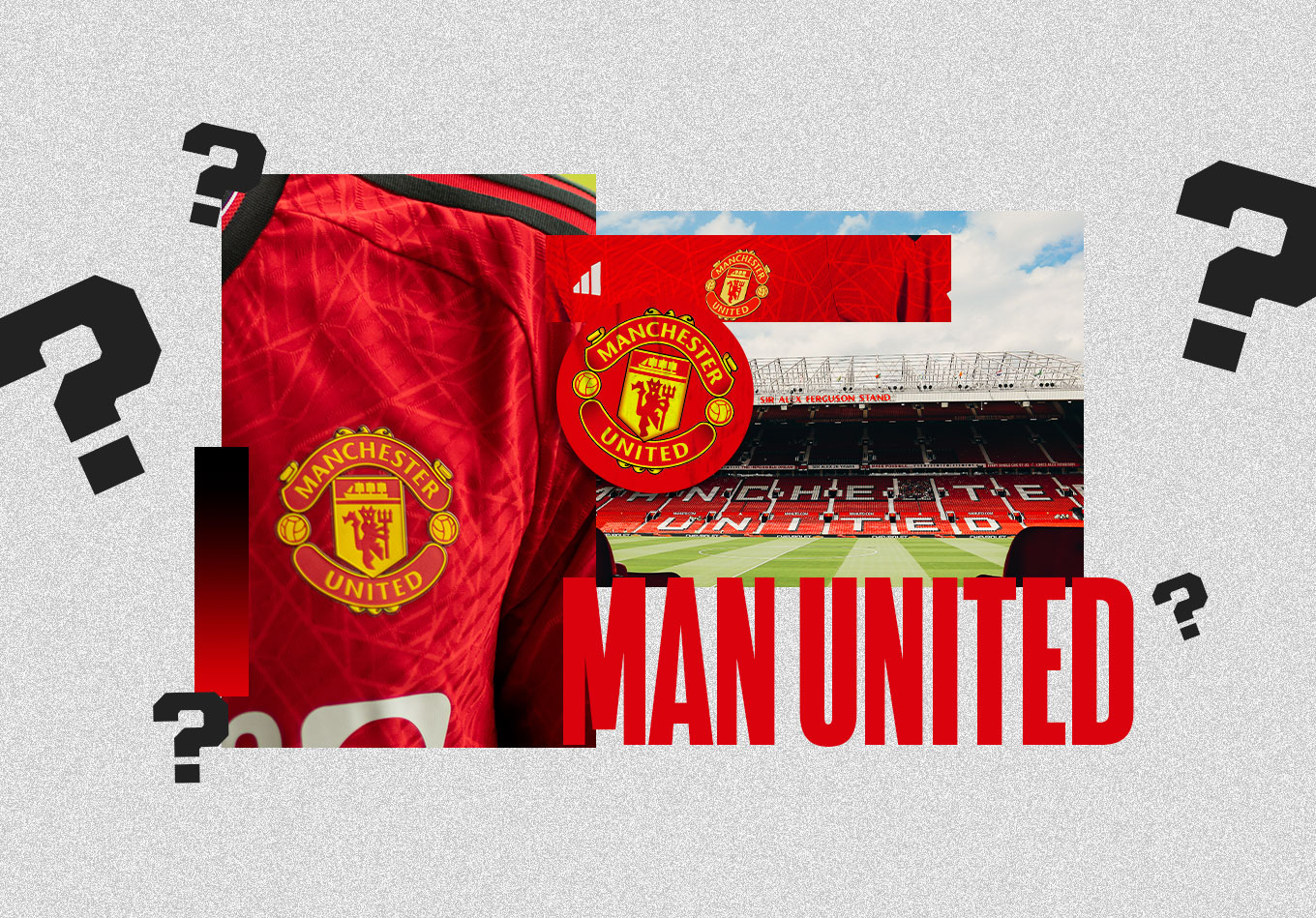Erik ten Hag made strides in terms of building something of a team identity and getting the best out of key players last season at Manchester United, ending a six-year trophy drought and getting them back into the UEFA Champions League in the process. But the Premier League stands still for no man. Ahead of 2023-24, we look at five burning questions around Man Utd as they look to build on Ten Hag’s promising debut campaign.
Will We See More Signs of Ten Hag’s ‘Philosophy’?
One of the key focuses among fans and journalists alike following United’s appointment of Ten Hag last year was their style of play; the Dutchman’s Ajax team had a distinct, effective way of playing that was clearly one of the reasons he was hired.
Some might have somewhat naively expected that system to be implemented quickly, even without wholesale changes to the squad. But the reality, which was laid bare in refreshingly honest fashion by Ralf Rangnick last year, was that Ten Hag inherited a squad built by several managers with vastly different ideas. And Ten Hag was another.
Nevertheless, Ten Hag did offer clarity when quizzed on how he wanted his team to play. During the 2022 pre-season, he said: “We want to press, we want to press all day and play proactive football. Sometimes we can do that high but if not possible, we have to read it as a team and drop lower. But we want to press and that has to be the intention all day.”
And before that, in Ten Hag’s first press conference as United boss in May 2022, he said: “Maybe you have seen Ajax? And I like that, but it is always players who dictate the way of play. I have the ideal, I will line up my best team, and I will line up my players like that to get the best out of them. That they can go to the maximum, that they feel comfortable in the role and in the end, it’s about getting the success together.”
So, clearly Ten Hag wanted his team to bear a resemblance to his Ajax side, meaning they press aggressively and play attack-minded, possession-oriented football that involves building from the back, but he was wise enough to understand he’d have to adjust his expectations along the way.
Comparing the two teams directly is difficult because Ajax are a big fish in a small pond and the Premier League more closely resembles an ocean, but while you wouldn’t exactly say Ten Hag managed to mirror his Ajax system at United, the graphics below highlight that there’s not a huge gulf between the two in terms of style in possession.
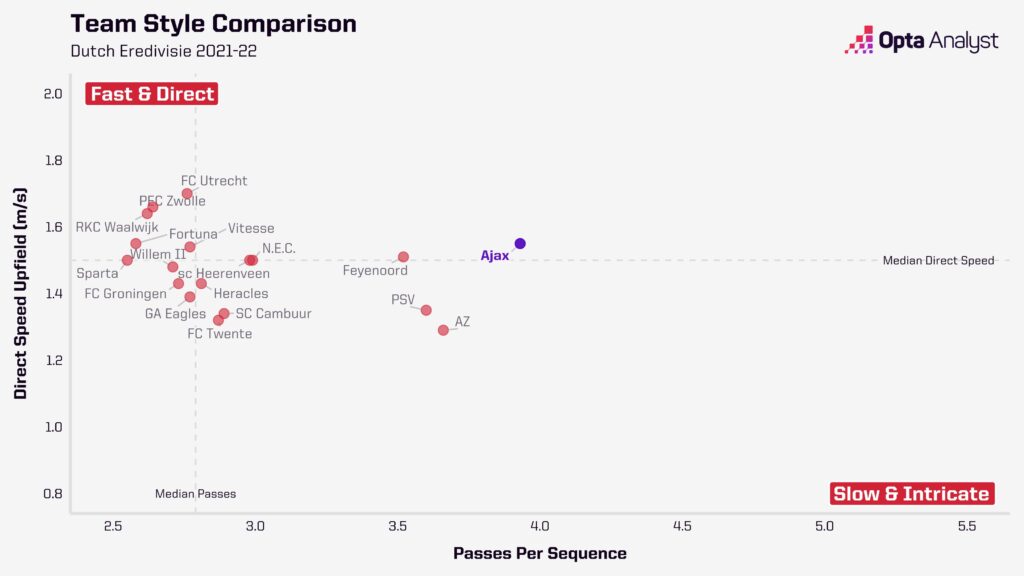
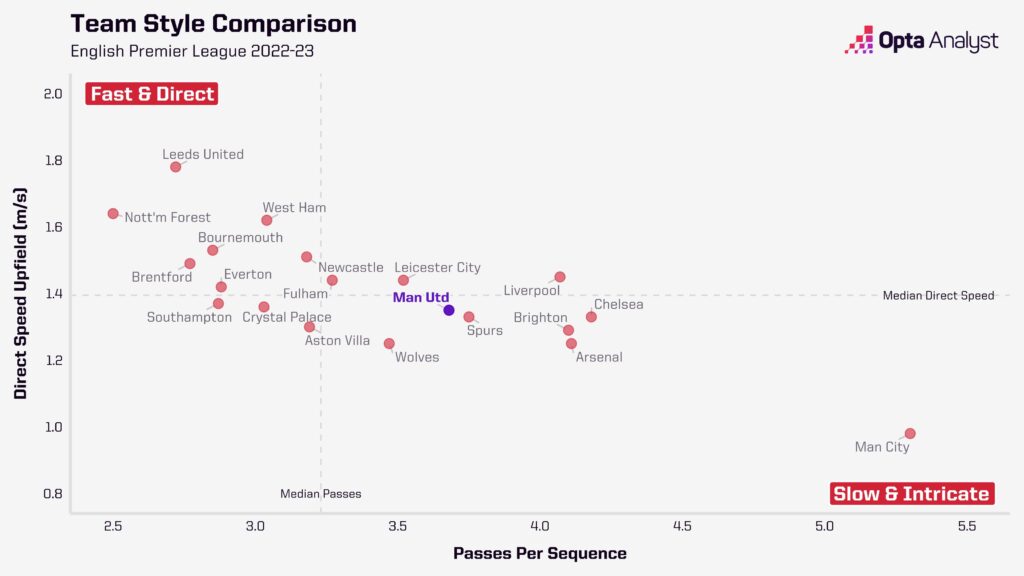
Players like Christian Eriksen, Casemiro and Lisandro Martínez – all new signings last year – were important in making United more competent in playing out from the back and through the lines; the difference is, the standard in the Premier League’s generally much higher than the Eredivisie and there are far more clubs capable of playing a similar way. So, although United’s output might look close to Ajax on our graphics, you have to also consider league context: Ajax were outliers in the Eredivisie, whereas United aren’t even close to being that in England.
After all, five Premier League clubs comfortably bettered their 423 sequences involving 10 or more passes; 99 of those sequences led to a shot or a touch in the opposition’s box, which was only good enough to be the seventh best in the Premier League. However, Ten Hag did discover how dangerous United can be in transition, registering more direct attacks (102) and goals from such situations (9) than any other club in the top flight, and this is likely to be an area he continues to focus on.
As for pressing, we can work out how intense a team’s efforts are when attempting to win the ball back by dividing the opposition’s total passes by the defending team’s defensive actions (passes per defensive action, or PPDA); the lower the number, the harder a team works. United’s average of 12 PPDA was only the eighth lowest in the division. For reference, Ajax’s in the 2021-22 season was 9.0.
However, their increase in high turnovers from 265 (13th) in 2021-22 to 328 (6th) last season is strong evidence Ten Hag’s already made an impression, giving United a solid platform for further improvement next season assuming the manager gets the rest of the players he wants before the transfer deadline.
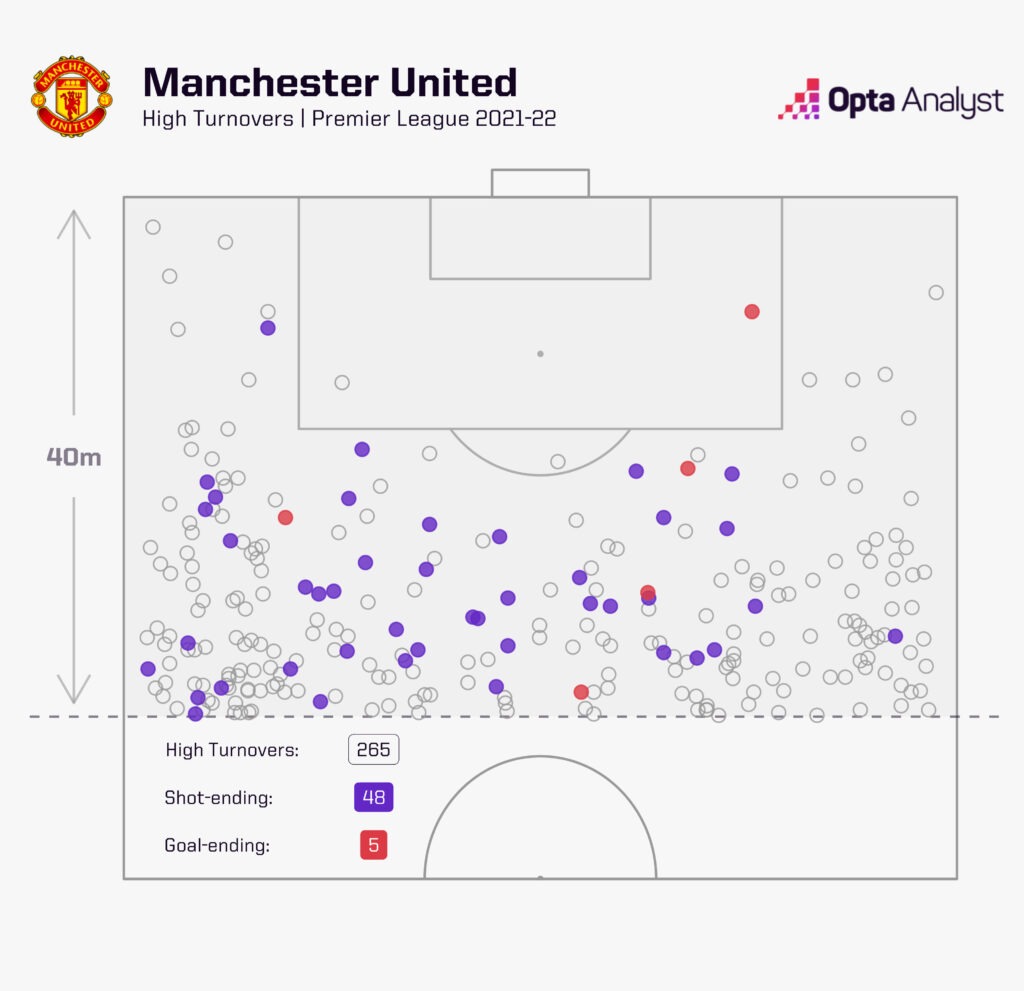
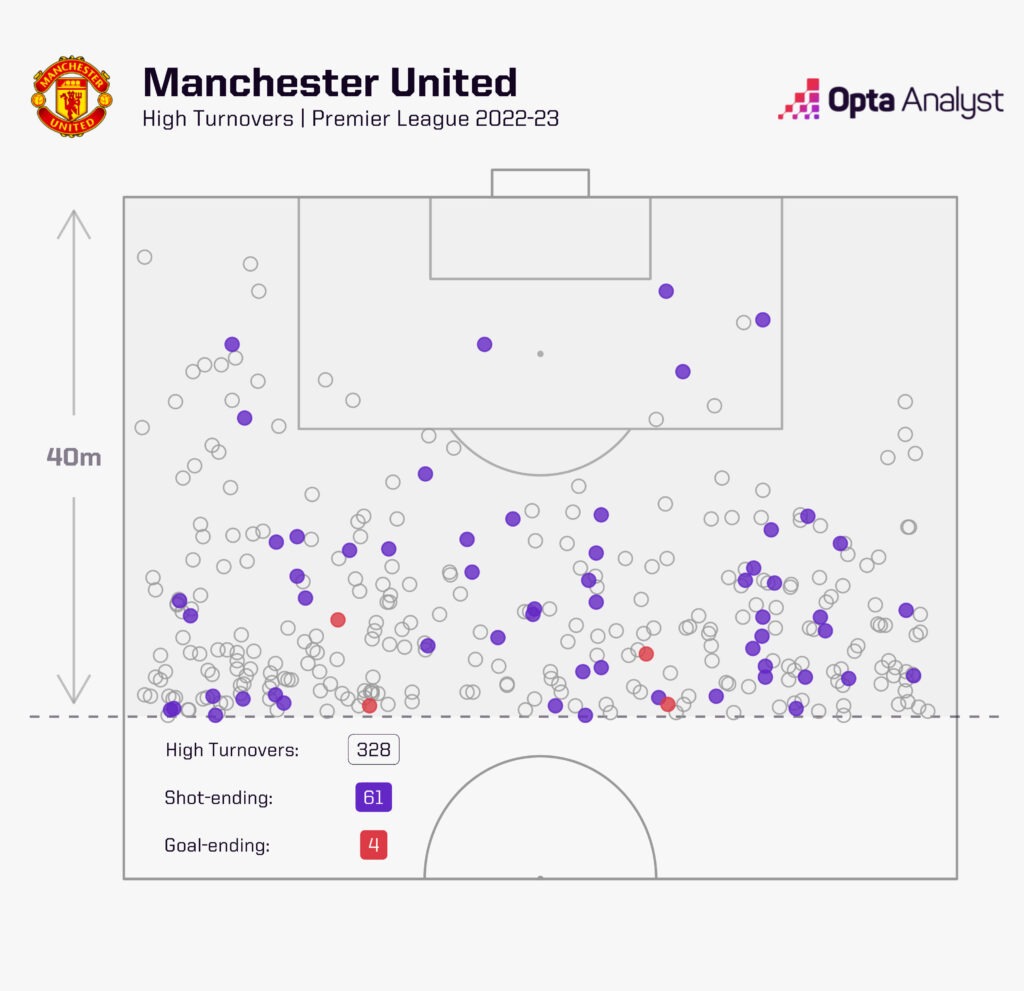
How Much of an Impact Could Onana Have?
One of the primary targets Ten Hag has already managed to acquire is, of course, André Onana, and his arrival has the potential to be a gamechanger. In fact, with respect to making United more of a bona fide possession-based team, the Cameroonian goalkeeper will probably be their most important signing of the summer, regardless of who else ultimately joins.
So much discussion time and column inches were dedicated to United’s goalkeeper conundrum last season and in the final weeks of David de Gea’s 12-year stay at Old Trafford. The Spaniard long seemed on borrowed time, at least with respect to being first choice.
But it wasn’t just about playing short from the back. That’s only one facet of being a good ball-playing goalkeeper; there’s no point being a technically gifted keeper if you lack the awareness or vision of the wider situation when you’re on the ball. You end up with instances like an encircled Harry Maguire coughing up possession on the edge of the box away to Sevilla, or Christian Eriksen getting robbed inside his own area at Brentford.
After the latter incident, Ten Hag told reporters: “[Eriksen] didn’t have to receive the ball there, because we give options [to De Gea] and the players have to choose, but we said play long, invite them and play long. I don’t want to play from the back when it’s not possible. It was naive how we played today; you have to play more direct. We attracted them, the space was high up the pitch, you have to do that option but that is what we didn’t do.”
This is why Onana could be so important. He is a goalkeeper who plays on the edge, and that’ll require a little getting used to for some fans, but above all he’s an expert distributor. Last season his 93.8% pass accuracy in his own half was only bettered by 12 goalkeepers (minimum 1,000 minutes played) across Europe’s top five leagues, and just three of those attempted more on a per-90-minute basis (28.8). De Gea, by comparison, found a team-mate with 88% of passes in his own half from 19.3 every 90 minutes.
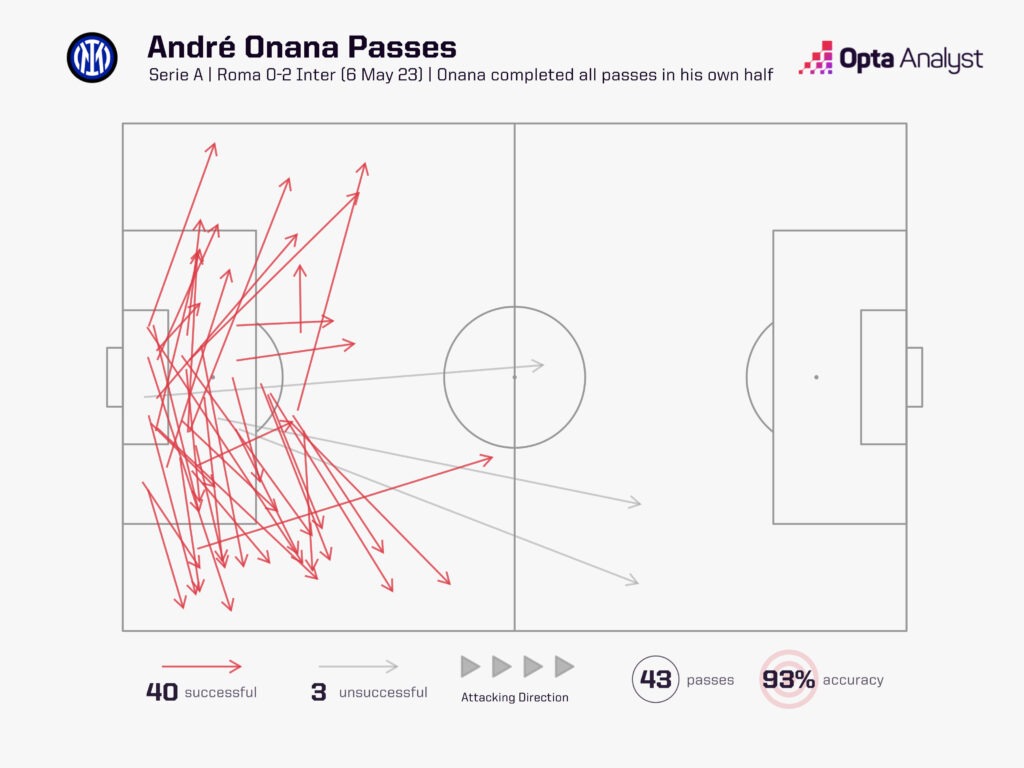
Onana also played a role in 1.7 open-play shot-ending sequences per 90 in Serie A last season, which just two goalkeepers (minimum 650 minutes played) across the top five leagues could trump. Meanwhile, his four combined chances created and secondary chances created – which is the pass before the pass that sets up a shot – was second only to Lazio’s Ivan Provedel (who played nearly 1,300 more minutes) in Italy’s top tier, highlighting how Onana’s also capable of going more direct when the time is right.
So, not only is Onana already used to seeing a lot of the ball, he’s generally reliable and has the range to go long when needed. There could be a period of adjustment; the Premier League is quicker and more intense than Serie A, and he’ll need to get used to (some of) his teammates (he played with Martínez at Ajax), so it’d only be natural for Onana to take a bit of time to find his feet. But United are going to be better at playing out from the back this season with him, and in a league where pressing is so in vogue, the gains could be considerable.
Can Ten Hag Get More From Sancho and Antony?
In Antony and Jadon Sancho, United have a couple of wingers who cost in excess of £150 million; considering what they’ve contributed so far, it’s an astonishing amount of money, but that’s not to say they’re lost causes.
Antony’s had one season in England and, while he may not have set the world alight, he clearly possesses ability and work rate. In terms of raw minerals, there’s still a lot there to work with and there’s nothing to say he can’t push on and find another level next season.
Sancho is entering his third season with United and the jury is still out; he’s not got anywhere close to the standard – or numbers – he showed at Borussia Dortmund, but the second half of the 2022-23 season showed hints of promise.
The Manchester City academy product required time away from United last season to improve his mental and physical wellbeing. He didn’t play at all between 22 October and 1 February, with Ten Hag giving Sancho the space and patience he seemingly required.
After his return, and considering the concerning nature of his absence, Sancho’s form in the latter part of the season was generally positive. He finished the campaign with the second-most chances created (44) and expected assists (4.1) among United players in the Premier League, and his tally of six goals was bettered by only Marcus Rashford (17) and Bruno Fernandes (8).
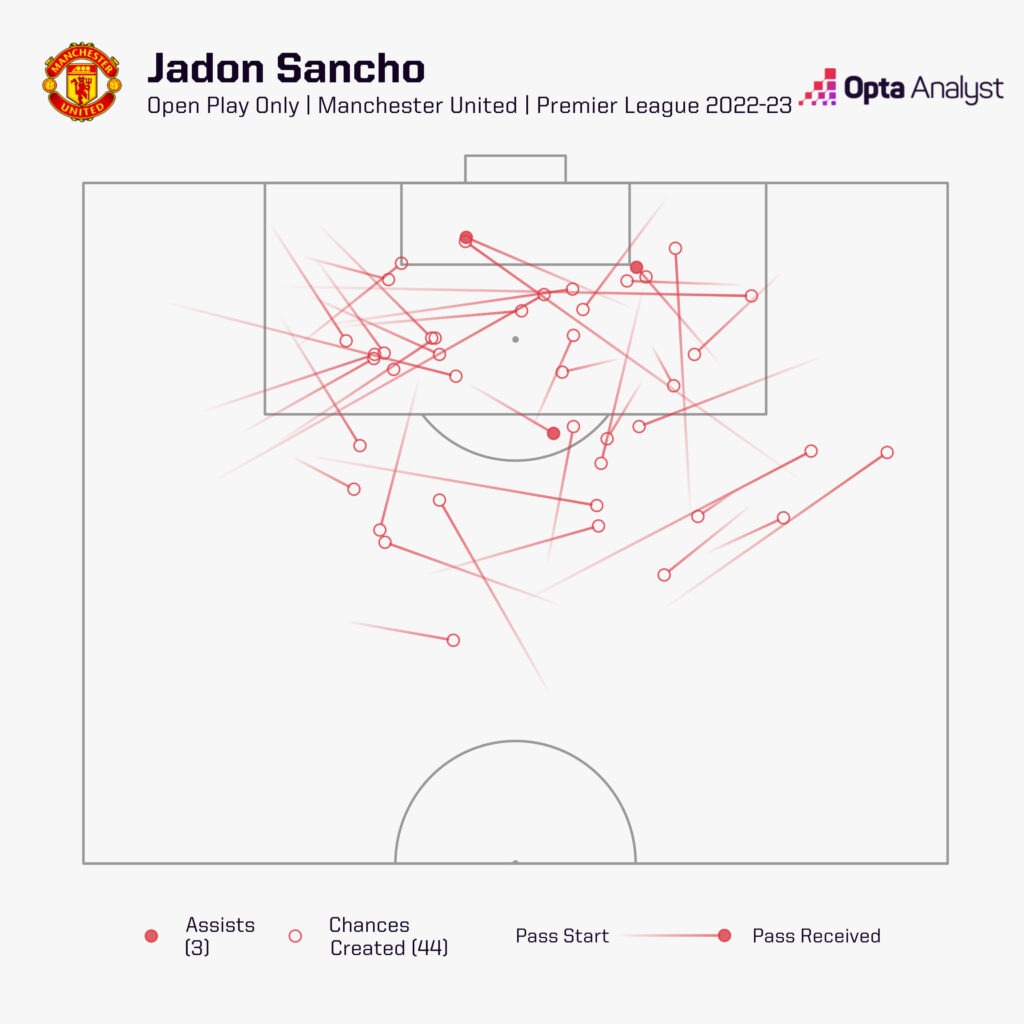
In fact, his 0.26 xG assisted on a per-90-minute basis over the season was bettered by only four players across the entire Premier League (minimum 25 chances created), while Sancho’s combined 4.1 chances or secondary chances created per game was second only to Fernandes (4.2) in the top flight (minimum 1,000 minutes played). So, not only was he finding teammates in good positions, he was also frequently involved in United’s build-up play. Some fans find him frustrating because of his tendency to slow play down in the final third, but this is all evidence that he’s doing something right.
Antony didn’t offer quite the same level of creativity or build-up involvement, laying on 17 fewer chances than Sancho from 117 more minutes on the pitch. But his combined 2.5 chances or secondary chances created per 90 wasn’t bad, ranking him 15th among players with at least 1,000 minutes played last season.
Part of that comes down to decision making. Antony shoots. A lot. He attempted 3.6 every 90 minutes in 2022-23, with Rashford (also 3.6) the only other United player to feature for at least 600 minutes to average over 3.0 shots per game.
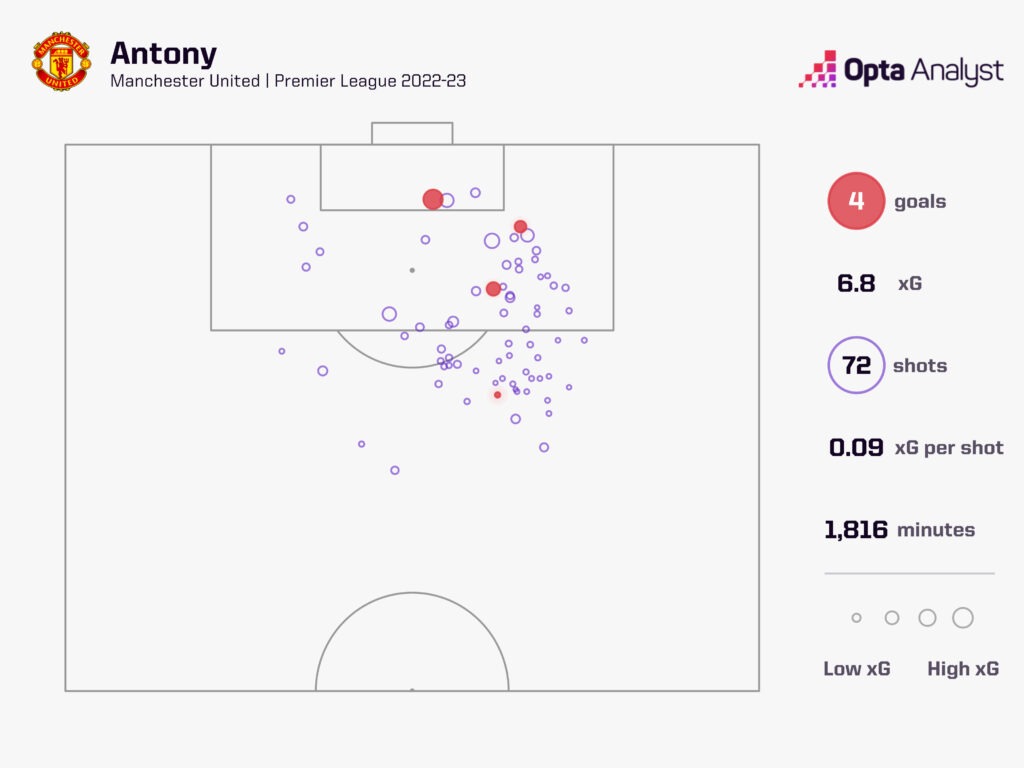
That did translate to 6.8 xG (excluding penalties), behind only Rashford and Fernandes in the United squad, but he turned those opportunities into just four goals. It’s unlikely his habits are going to dramatically change; he’ll continue to get plenty of shots away, he just needs to work on getting into better positions and making smarter decisions.
The average xG value of his shots was 0.09, lower than Anthony Martial (0.23), Sancho (0.20), Rashford (0.15), Wout Weghorst (0.14), Alejandro Garnacho (0.13) and several others in the United team.
So, back to the question; yes, Ten Hag can definitely get more from both players, but he’s not going to be without selection dilemmas. With United’s impending signing of Rasmus Højlund, three of the four advanced roles are generally going to be taken up by him, Rashford on the left and Fernandes as the number 10, leaving the right-wing berth as the least sewn-up.
It’ll be on Sancho and Antony to prove their worth as early and as consistently as possible.
Will Mount Supplant Eriksen?
Eriksen was undoubtedly a positive addition to Manchester United last summer. He instantly brought some ball-playing nous and control to a midfield that had been sorely lacking, even taking a bit of the creative burden off Fernandes.
Once Casemiro had settled and forced his way into the starting XI, the trio of him, Eriksen and Fernandes gave United the kind of midfield quality – and balance – they’d arguably lacked for years. Sure, the other two might have been seen by most as the biggest contributors to that, but Eriksen more than played his part.
Those three started together 25 times across all competitions last season, and United won 76% of the time, losing just twice. Their win rate dropped to 59.5% in the 37 matches that had at least one of them missing from the starting XI, suffering 10 defeats.
Eriksen missed over two months of the season through injury between late January and early April, and after his return there was undoubtedly a perception he’d often run out of steam. Before his absence, the Dane averaged nearly 79 minutes per game over 19 matches in the league; afterwards, his average dropped to 56 and a half minutes over a 10-game spell.
This isn’t a criticism; needing a bit of time to get back up to speed after a lengthy injury absence is completely fair. However, there’s no doubt Eriksen’s influence waned, going from 62.1 touches per game pre-injury to 51.9 post, and the concern heading into next season would be that this was a trend rather than just a temporary blip.
Had United’s back-up options been better than Fred and Scott McTominay, neither of whom are even remotely similar to Eriksen in style, then perhaps it’d have been less of a problem. With that in mind, then, there’s no wonder Ten Hag was so insistent on bringing Mason Mount to the club.
Some United fans weren’t particularly excited by the England international’s arrival, particularly on the back of a disappointing 2022-23 individually at Chelsea. But, given the chaos at Stamford Bridge last term, it almost feels like there should be an asterisk against that season.
After all, with respect to Mount, there’s a reason coaches tend to adore him as a player, and he was one of the Premier League’s best players across the 2020-21 and 2021-22 seasons. He ranked fifth over that period for chances created (145), fourth for expected assists (13.8) and 21st for possession regains in the final third (40), which was 10 more than any of his teammates in a Chelsea side utilised the second-most intense press in the division (10.2 PPDA).
He did all of that and was still a vital cog in general build-up play, ranking seventh for total shot-ending sequence involvements (375) and fifth on a per-90 basis (6.5, minimum 4,000 minutes played) in the Premier League.
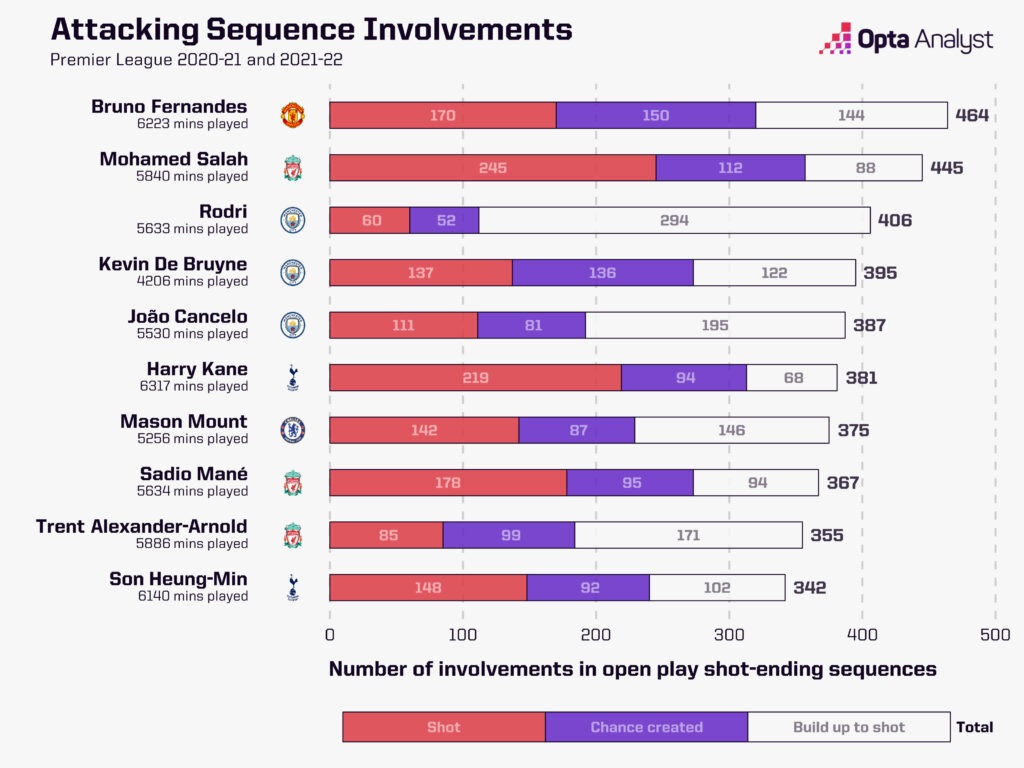
Eriksen’s a talented player, but he doesn’t possess the same breadth of strengths – and that’s fine. There’s an argument that signing a player like Mount will help maximise Eriksen’s greatest abilities because there’s less of a need for him to be stretched physically.
Yes, out of Casemiro, Fernandes and Eriksen, the latter is the likeliest to see his game time impacted by Mount’s arrival, though it’s worth remembering Ten Hag’s side played 62 games last season and they’ll be in four competitions – at least initially – again in 2023-24; there will be opportunities.
That’s not to say Eriksen definitely won’t consider his options if Sofyan Amrabat signs as well, but over the past decade United have struggled to build on promising seasons. Now, they seem to be making a conscious effort to kick on, and that requires strength in depth.
How Important Will the Signing of Rasmus Hojlund Be?
The overall positivity around Man Utd’s 2022-23 season was underpinned by the fact their deficiencies and weaknesses were quite obvious, meaning they were theoretically straightforward to correct. Some have already been referenced in this article with the goalkeeper situation and the need to address midfield depth.
But arguably even more glaring was United’s need to add a new striker. In fact, it’s been a suspect area of the pitch for several years. Romelu Lukaku was the last genuine No.9 with promise that they signed, way back in 2017. Of course, that move didn’t work out, but at the time he was a striker who’d “done it” in the Premier League and age was on his side.
Since then, United have been restricted to (or restricted themselves to…) short-term loan options or players who were generally heading towards the end of their careers. Cristiano Ronaldo, Edinson Cavani, Odion Ighalo and Wout Weghorst have all come and gone without making particularly lasting impressions, so many fans have been crying out for them to invest in either a world-class centre-forward in their prime or a highly rated prospect with bags of potential.
A move for Harry Kane never materialised, and so Rasmus Hojlund quickly emerged as the primary target. The Denmark international, 20, had a medical this week and is expected to complete a transfer worth up to £72million this weekend; it’s a deal that should excite supporters.
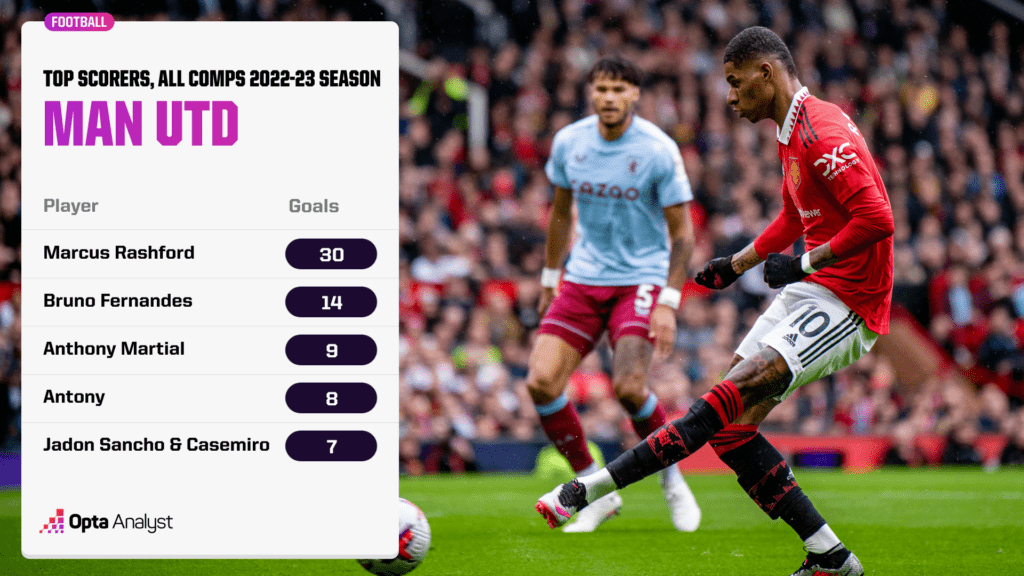
United’s 58 goals last season was comfortably the fewest of the clubs to finish in the top six, and yet creativity wasn’t an issue; only Manchester City (59) boasted more xG than them (56.6) in open play. The problem was finishing the opportunities, as United turned those chances into just 48 goals, whereas City managed 69.
It’s been a problem in pre-season as well. “Absolutely,” Ten Hag said after the recent defeat to Real Madrid when asked if he needed more attacking reinforcements. “Two things: the pressing can be better from the start and scoring goals. I think we need more players capable to be one-on-one. We had the situations. It was Rashford, McTominay and [Alejandro] Garnacho. You have to score. We created some very good chances but we have to be more clinical and score goals from those situations.”
Essentially, they need someone who can reliably finish the chances they create. It remains to be seen if Hojlund is ‘the one’. After all, he’s only played one full season in a top league and he’s not exactly been prolific, but his profile is one that looks well-suited to United and the Premier League given he’s athletic, a decent finisher and technically very good.
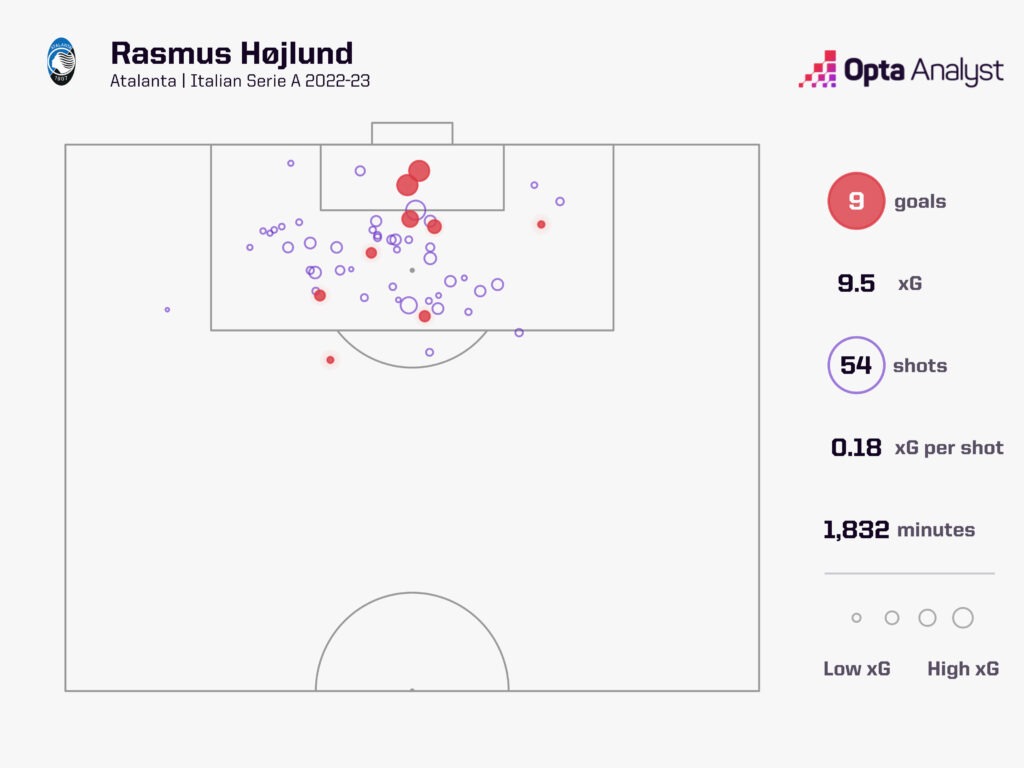
He’ll likely require some time to adjust and develop – don’t be expecting a first season like Erling Haaland’s. So, we could still see Rashford occasionally deployed through the middle, which might sound like it negates the point of signing Hojlund in the first place, but again we come back to the need for depth and options; Anthony Martial simply isn’t reliable enough in terms of fitness to be considered the first-choice striker.
In the longer term, the presence of an established, regular centre-forward should help take some of the goal-scoring burden off Rashford, because even though he had a fine season last term, many are still sceptical about him displaying such levels over a longer period. Ten Hag has challenged him to regularly score 40 goals a season, but how realistic is that? Obviously, if he can reach such levels and United have Hojlund scoring upwards of 20 per season from the middle, they’ll be laughing.
So, there’s clearly scope for Hojlund’s arrival to have a huge impact if he fulfils the potential United seemingly believe he has. But looking to the more immediate future, it’ll just feel refreshing for many supporters that the club appears to be finally moving on from Martial, and the new man leading the line will have his whole career in front of him rather than behind.
You want to read more Premier League season previews? Click on the links below:
Manchester City
Chelsea
Arsenal
Liverpool
Newcastle United
Tottenham Hotspur
Enjoy this? Subscribe to our mailing list to receive exclusive weekly content. And follow us on Twitter too.
